Welcome to the world of Parmigiano Reggiano, the king of cheeses! As a cheesemonger, you understand the importance of precision and expertise in handling this exquisite Italian delicacy. In this comprehensive guide, we will explore the tools required for cutting it and essential tips to ensure the cheese is well taken care of. Read on to learn how to cut a wheel of Parmigiano Reggiano like a pro!
SEE ALSO: The history and production of Parmigiano Reggiano →
All videos and images used in this blog post are credited to the Parmigiano Reggiano Consortium.
Parmigiano Reggiano: The king of Italian cheeses
Parmigiano Reggiano, often referred to as the “King of Cheeses“, hails from the Emilia-Romagna region in Italy. Crafted from raw cow’s milk, it undergoes a meticulous ageing process, resulting in a cheese renowned for its nutty flavour and granular texture.
The cheese boasts a complex flavour profile, ranging from fruity and nutty to savoury and slightly salty. Moreover, its aroma is rich and earthy, evoking a sense of tradition and craftsmanship.
The Parmigiano Reggiano wheel: A northern Italian icon
A Parmigiano Reggiano wheel is a masterpiece, a result of centuries-old craftsmanship and tradition. It takes about 550 L of milk to produce one massive wheel of cheese.
Dimensions of the wheel
Parmigiano Reggiano DOP is cylindrical in shape, with a diameter of 35-45 cm (14-18 in), a height of 20-26 cm (8-10 in), and an average weight of 40-42 kg (88-92 lbs).
The rind of Parmigiano Reggiano is smooth and hard, a stark contrast to the smooth interior of the cheese. This hard and thick (about 1 cm) rind develops during the ageing process as the cheese dries and hardens, creating a protective layer around the precious inner paste.
Flavour infusion
While the inner paste of Parmigiano Reggiano is the star of the show, the rind is not to be overlooked. Parmigiano Reggiano wheels are traditionally aged in large, well-ventilated warehouses.
The exposure to specific environmental conditions, including temperature and humidity fluctuations, influences the ageing process. These conditions contribute to the rind’s unique flavour profile, infusing it with the essence of the ageing cheese.
Cheesemongers and connoisseurs often appreciate the unique taste of the rind, considering it a delicacy in its own right. And the best way to explore this flavour is by cooking the rind in your favourite soup or pasta sauce.
Before cutting your wheel of cheese
Inspect your wheel of Parmigiano Reggiano
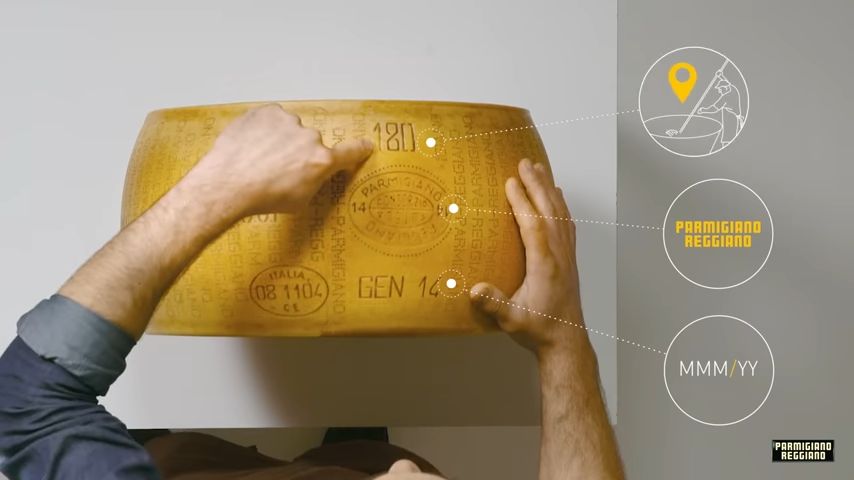
Let’s get started. First, inspect the cheese wheel for any cuts or deep cracks, and carefully examine the condition of the rind. Clean it thoroughly with a cloth to remove any grease or dust.
Next, look for the distinctive marks on the cheese. These include the certification mark, the month, and the year of ageing. The unique three or four-digit number identifies the dairy where the cheese was produced.
You can easily find out the dairy’s information by visiting the Parmigiano Reggiano consortium’s website.
Additionally, check for the casein tag on the bottom of the wheel; it serves as a unique tracking code for each cheese. Finally, ensure there is an EC inspection stamp on the lower side of the cheese wheel for authenticity and quality assurance.
Setting up your workstation
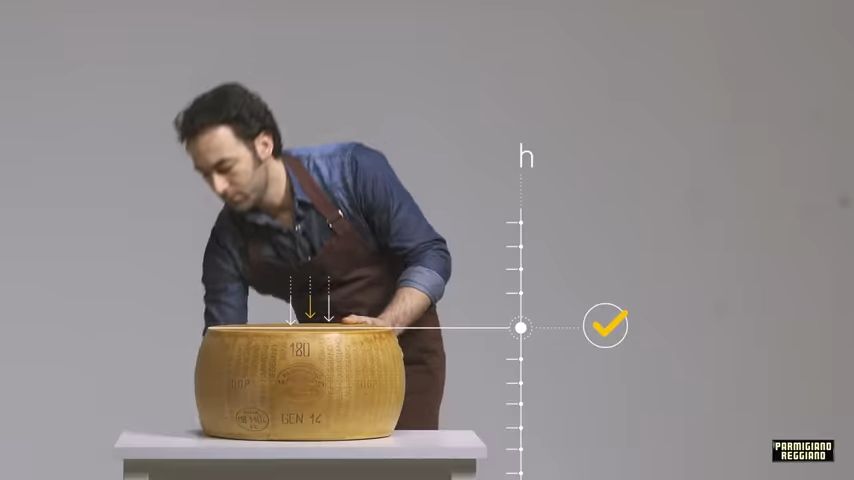
Ensure that the cheese wheel has reached room temperature and has been kept outside the cold room for a minimum of 24 hours. Position the wheel at a suitable height and angle that allows you to apply the necessary pressure for cutting.
If you notice any traces of grease, make sure to dry them thoroughly. This step will facilitate easier handling of the cheese.
Using the correct knives
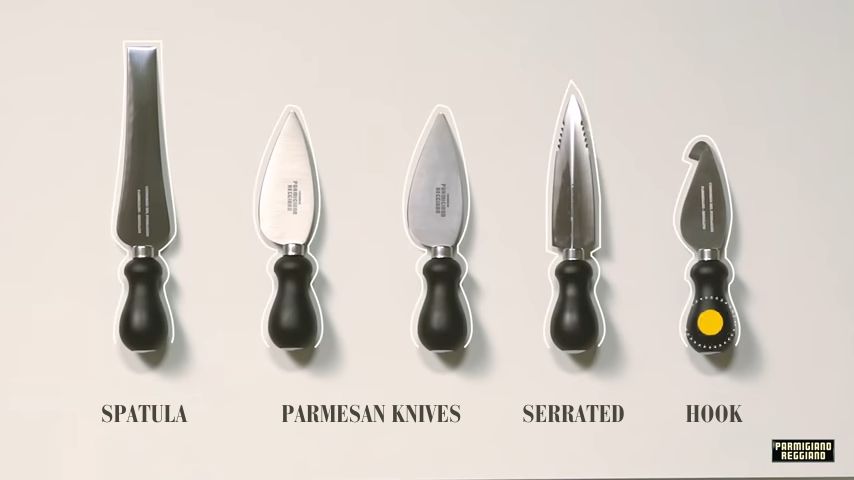
When it comes to cutting a wheel of Parmigiano Reggiano, having the right tools is essential. Enter the tagliagrana knives, a set of specialised tools designed to handle this culinary masterpiece with finesse and expertise.
To crack open your wheel of Parmigiano Reggiano, you will need the following tagliarana knives:
- One hook knife
- Two Parmesan cheese knives
- One knife with a serrated tip
- One cheese spatula
How to cut a wheel of Parmigiano Reggiano
Now, it’s time to determine how to open the wheel. You have two options:
- Vertical Cut: This method is more practical and is ideal for use in a store setting.
- Lateral Cut: The lateral cut is more elaborate and showy. It’s perfect for events such as buffets, trade fairs, or whenever you’re presenting in front of an audience.
Vertical cut: Step-by-step instructions to carve Parmigiano Reggiano vertically
Cutting into halves
To initiate a vertical cut, position the wheel horizontally and draw a central line across it using a Parmesan cheese knife, effectively dividing a flat portion into two semicircles.
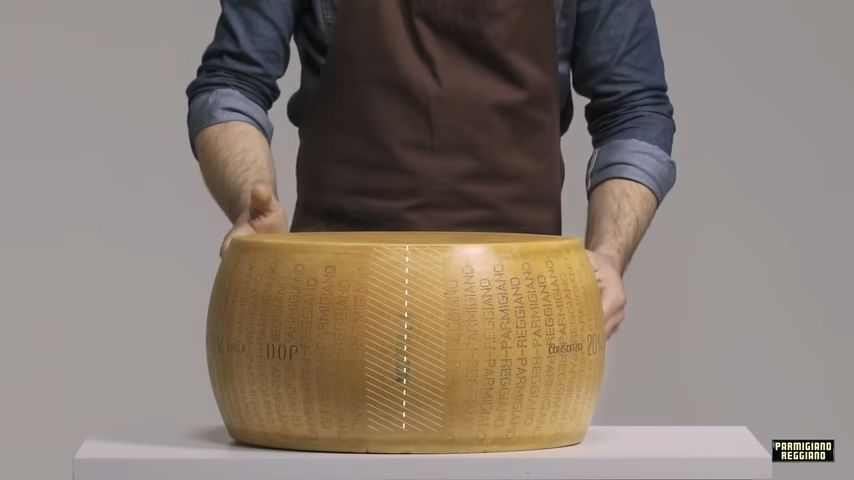
Split it exactly where the stamp is, ensuring the side without dots is behind it. This method minimises the risk of obtaining a slice without the characteristic dots.
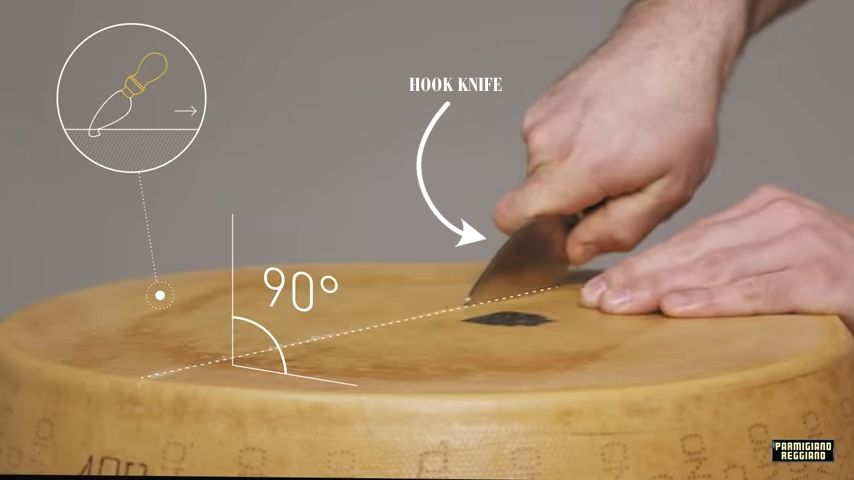
Using a hook knife, cut into the rind along the guide line, proceeding down the side.
Flip the wheel over and repeat the process, completing the rind cutting. To turn the wheel effectively, stand it upright, rotate it, and gently place it back down.
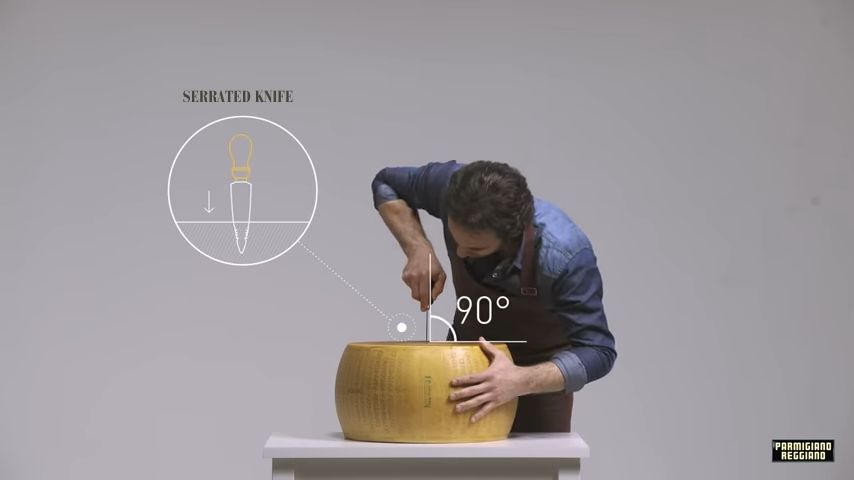
Insert a serrated-tip knife precisely into the centre of the flat part, ensuring it remains perfectly straight. Then, slide the Parmesan cheese knife into the edge where the flat part meets the side, ensuring the correct angle.
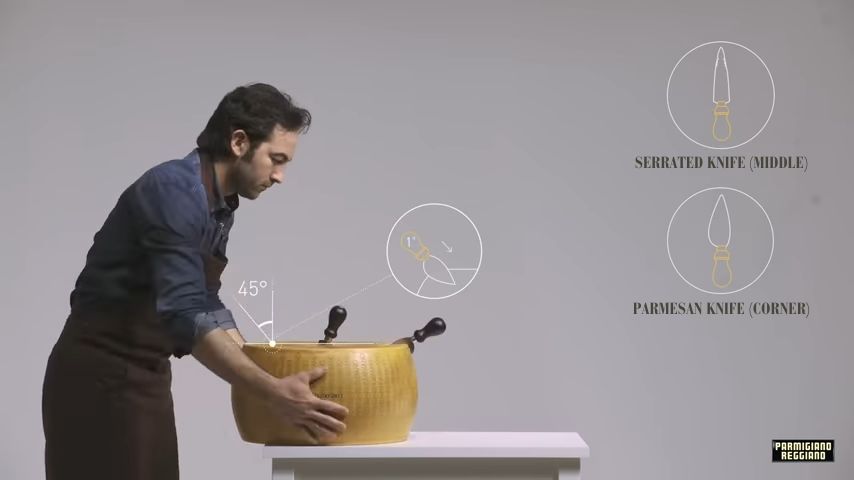
Rotate the wheel and insert the second Parmesan cheese knife. Wait briefly, remove all three knives, and flip the wheel over. Repeat the procedure on the opposite flat side, patiently awaiting a vertical crack to emerge.
Now, the wheel can be cracked open into two halves.
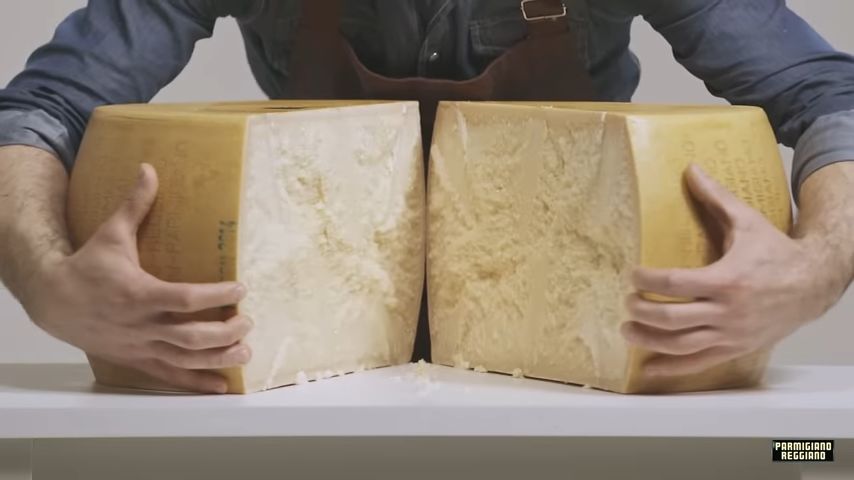
Cutting into quarters
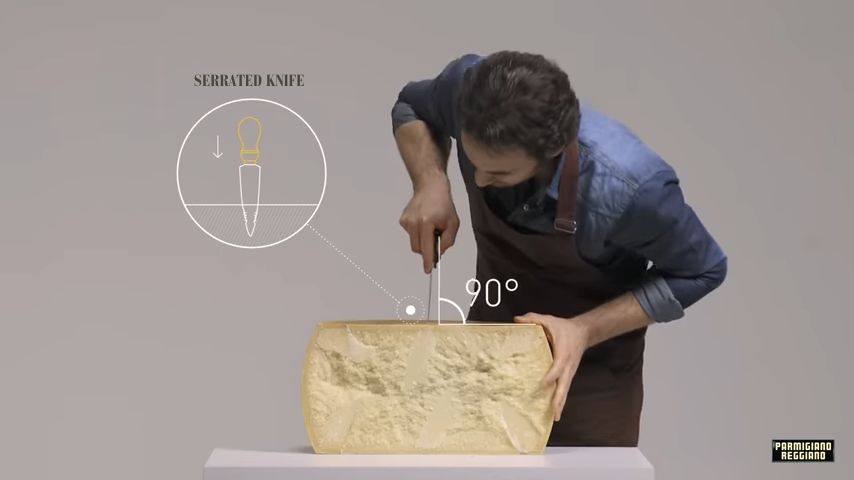
For further slicing, take one half and use a hook knife from the centre to the side. Flip the wheel, repeating the same steps. To finish marking the rind, insert the serrated-tip knife, creating a fracture line.
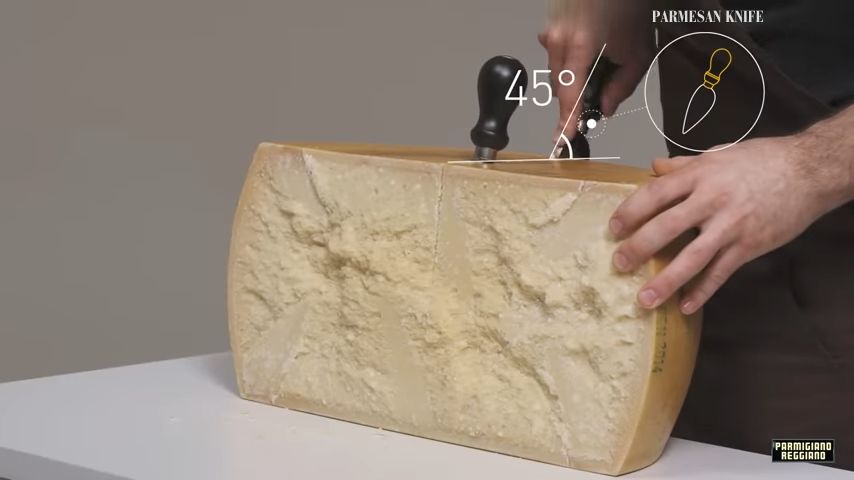
Insert a Parmesan cheese knife where the flat part meets the side, turning the half wheel around and repeating the step. It will now divide into two quarters.
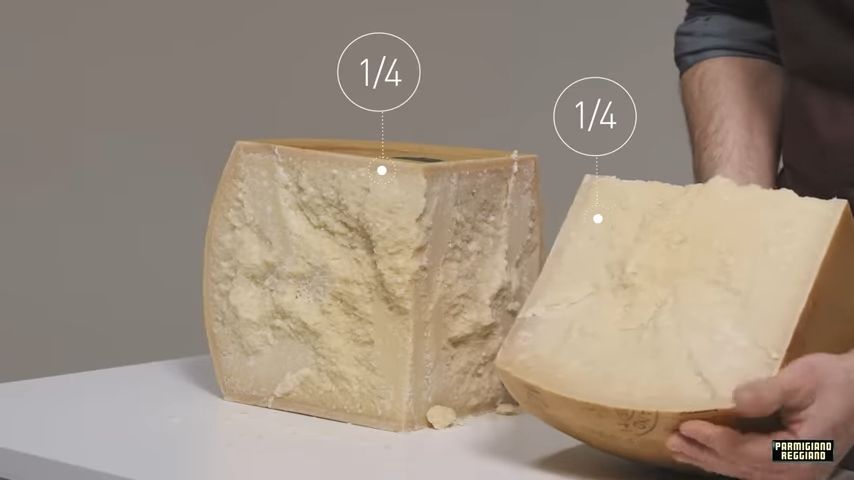
Cutting into eighths
Now, divide the wheel into two eighths. Choose the most stable side of the quarter and start working from there.
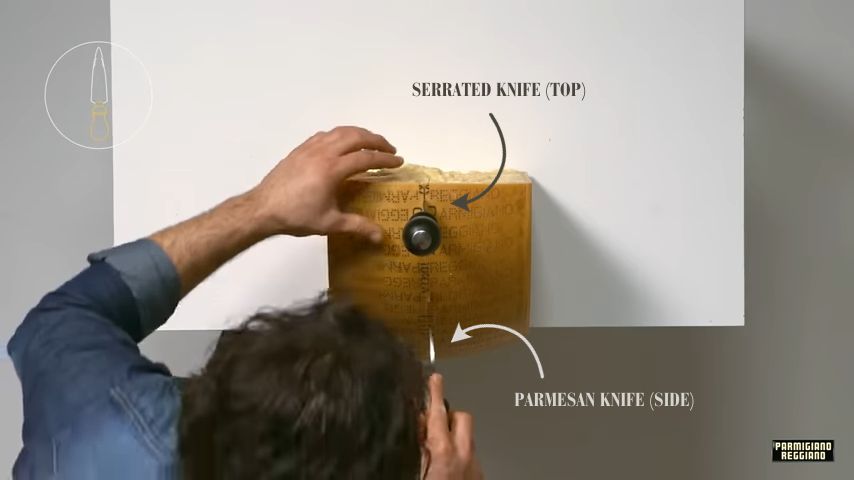
Mark the rind, using the serrated knife and then the Parmesan cheese knife. Turn the wheel over and separate the two halves with a serrated knife on the cheese side, taking care not to damage the upper part.
At this point, you have successfully divided the Parmigiano Reggiano wheel into two eighths.
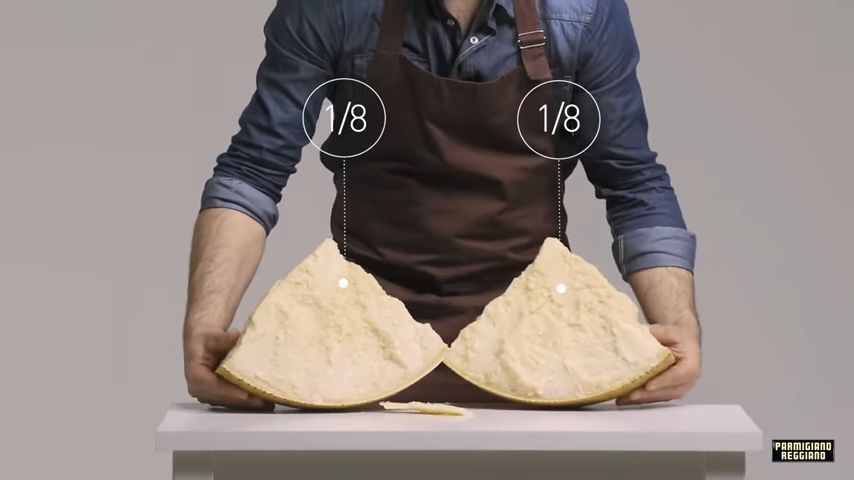
Lateral cut: Step-by-step instructions to carve Parmigiano Reggiano laterally
Start by positioning the cheese wheel vertically.
Cutting into halves
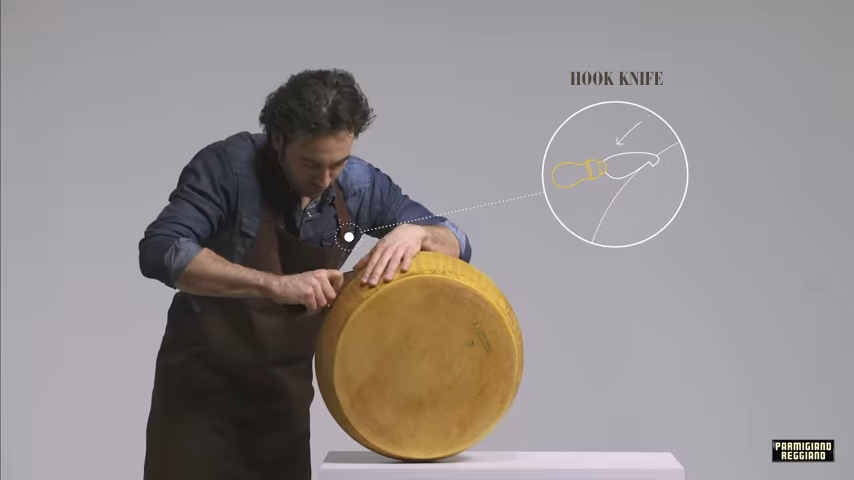
Using a hook knife, mark the rind by following the line of the central dot between the words “Parmigiano” and “Reggiano”.
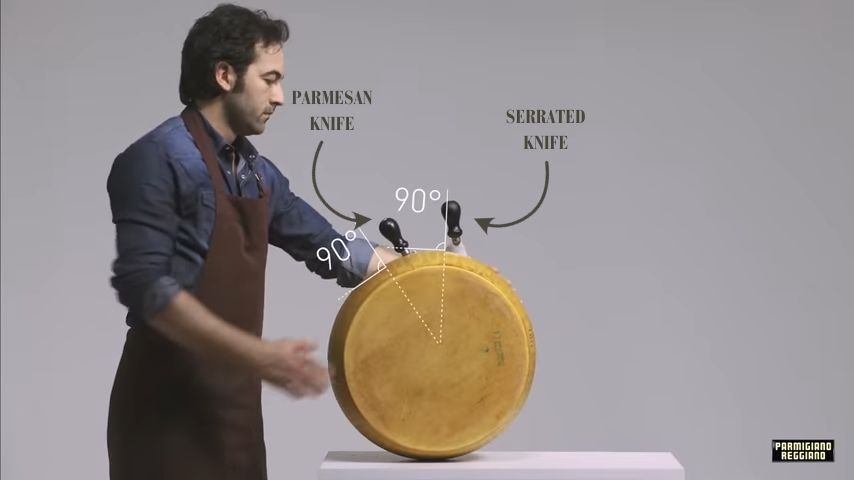
Sink the serrated cheese knife deep into the mark, repeating the process while rotating the wheel. Alternate between the Parmesan cheese knife and a serrated one.
Always ensure that the knife blade penetrates the cheese perpendicularly to the rind.
Once you’ve circled the wheel, if the halves haven’t loosened, repeat the procedure. This time, use the spatula. The wheel will naturally separate into two halves.
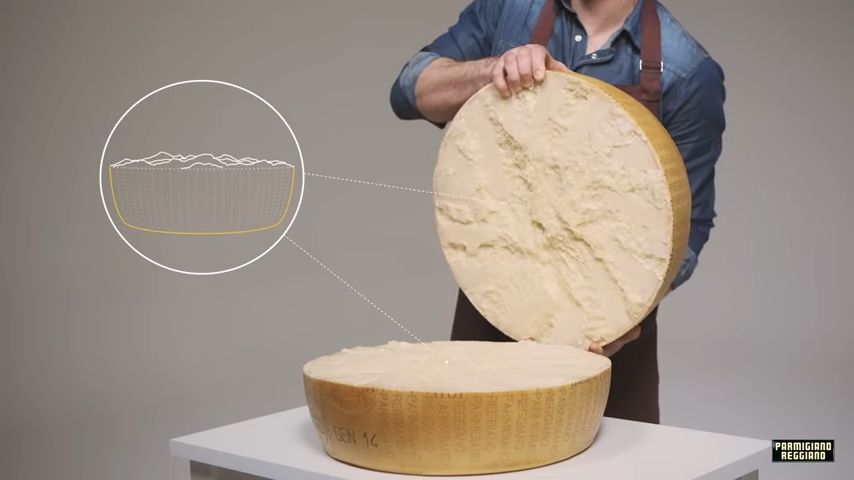
Cutting into quarters
Place the half wheel with the flat side up, marking a midline on the flat part with a hook knife. Continue cutting down the side.
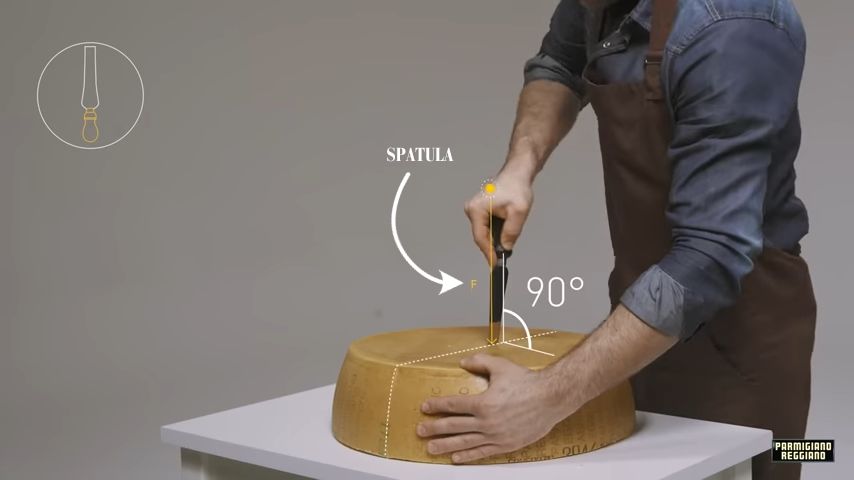
Insert the spatula into the centre and push the Parmesan cheese knife into the crust. Lift and lower it, ensuring a proper notch in the side. Rotate the wheel and repeat the process.
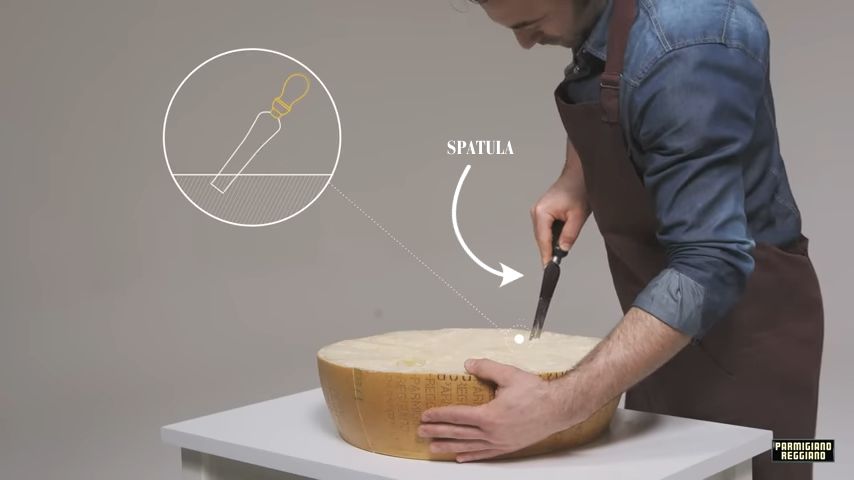
Next, flip the wheel upside down. Insert the spatula into the exposed cheese’s centre, then continue the process by turning the half wheel.
You’ll notice a fracture line forming. Separate the half wheel, resulting in two quarters of Parmigiano Reggiano.
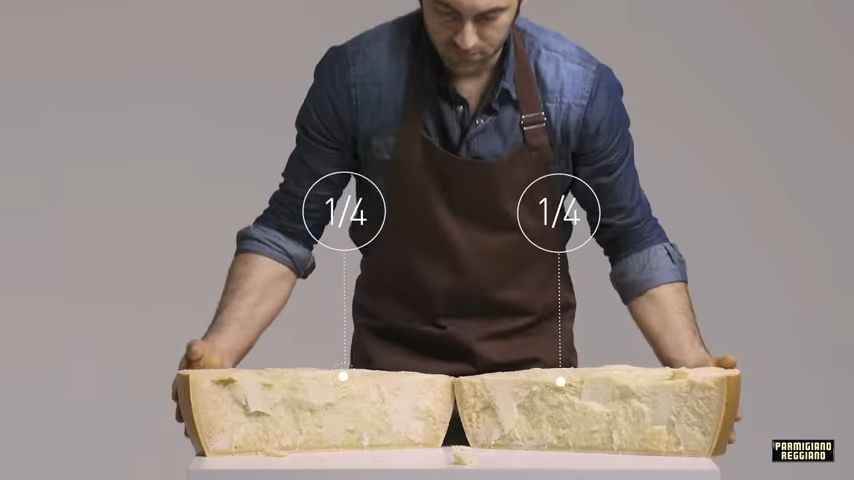
Cutting into eighths
Arrange the quarter with the rind facing up. Use a hooked knife, cutting from the centre of the fracture line outward on the flat part, and then on the side.
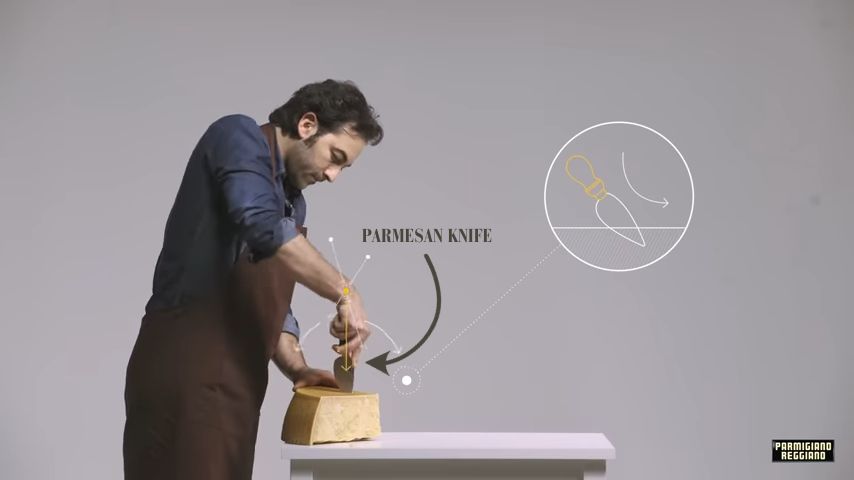
Repeat this operation with a Parmesan cheese knife to divide the two quarters.
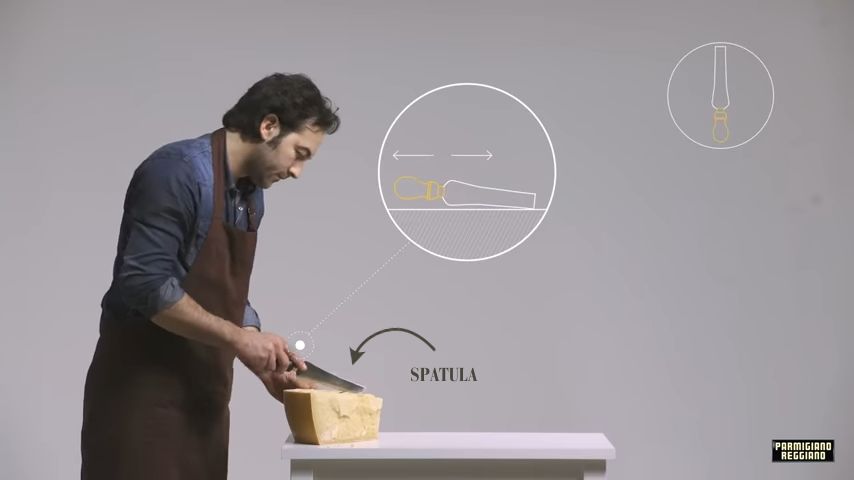
Turn the quarter and separate the cheese using both knives, starting with a spatula and then a Parmesan cheese knife.
Congratulations, you’ve successfully divided the Parmigiano Reggiano into two eighths.
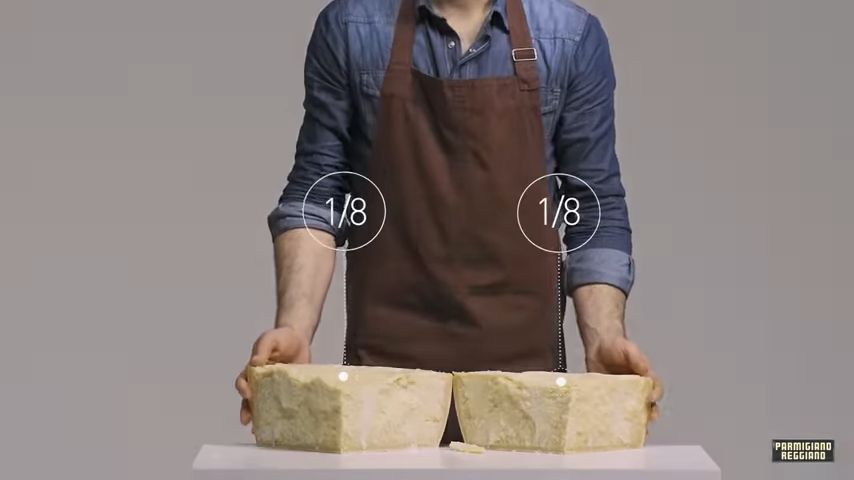
How to portion Parmigiano Reggiano
To continue with the portioning process, place the eighth of the wheel with the cheese facing downward. Take the Parmesan cheese knife and draw a line to divide the eighth in half.
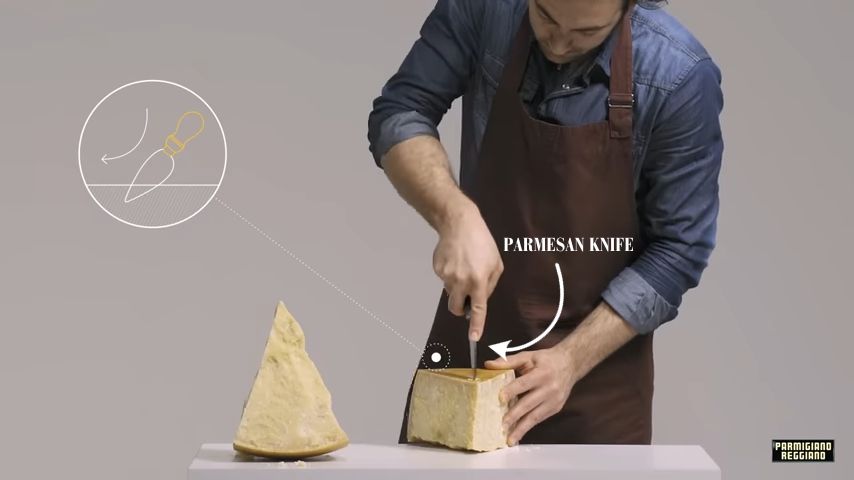
Insert the point of the Parmesan cheese knife and push it down, employing a consistent up-and-down motion. When you reach the side rind, make a sharp downward cut.
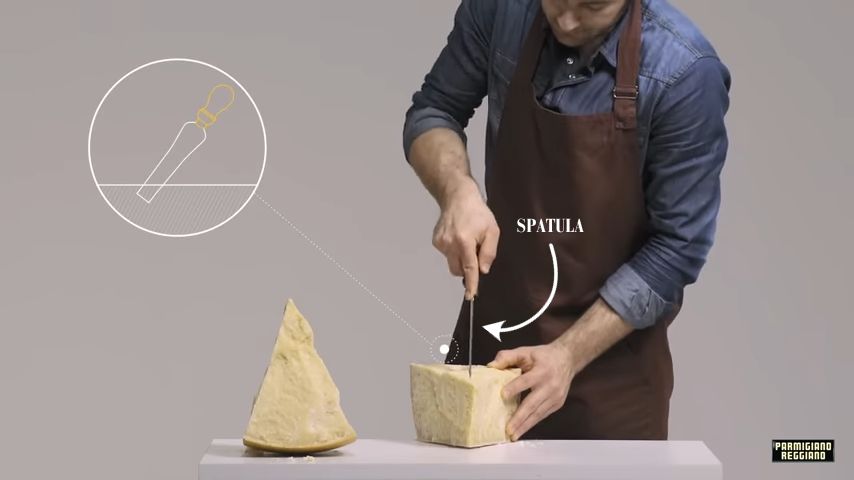
Now, with the inner cheese facing upwards, replicate the cut, alternating between the spatula and the Parmesan knife. Insert the point of the Parmesan cheese knife, ensuring the blade splits the rind. Repeat this process along the entire line.
Flip the eighth over and mark the midline with a spatula. Utilise the Parmesan cheese knife to separate the cheese, repeating this process for the remaining triangles.
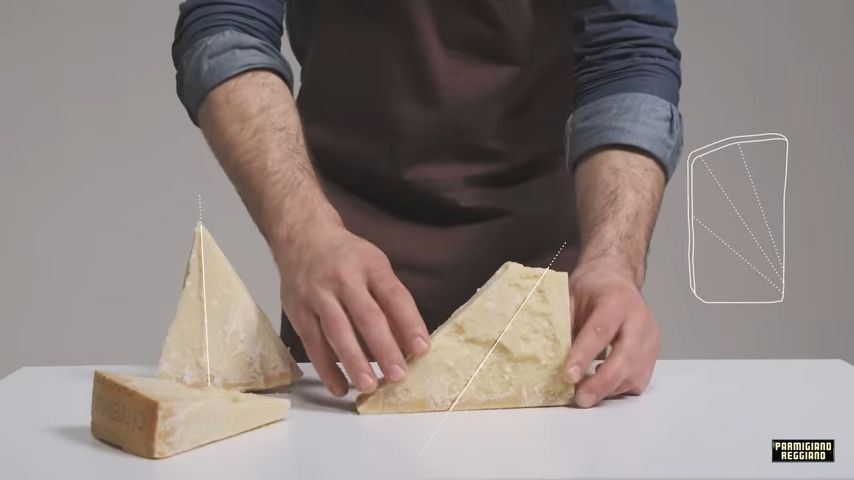
If you intend to cut smaller portions, use horizontal cuts to maintain an appropriate cheese-to-rind ratio. Alternatively, remove the rind from the flat part and then proceed with the horizontal cuts.
Always remember, precise portioning not only enhances presentation but also reduces waste, ensuring maximum utilisation of the exquisite Parmigiano Reggiano cheese.
How to wrap Parmigiano Reggiano
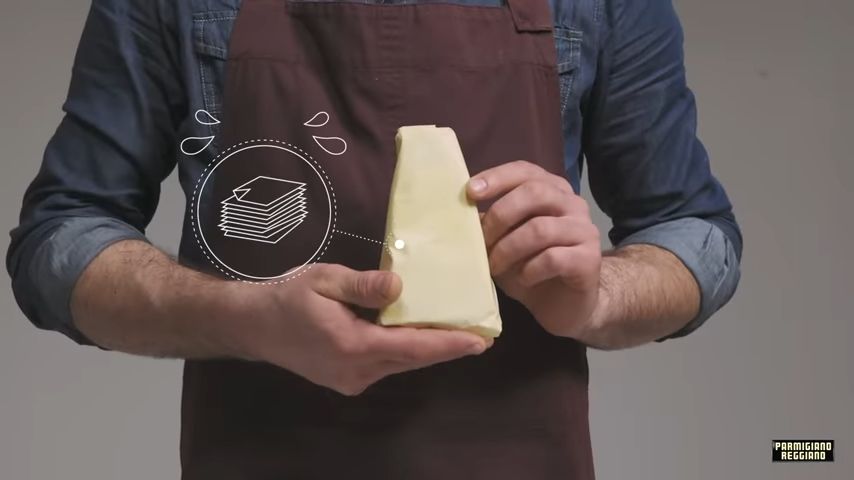
For the utmost quality, Parmigiano Reggiano cheese should be cut and graded upon customer request. For practical purposes, you can pre-package the cheese a day or two in advance.
When pre-packaging, there are two methods to consider:
- Using clear food wrap: Wrap the cheese securely with clear food wrap, ensuring it is well-sealed to maintain freshness.
- Using wax paper: After cutting the cheese, wrap it in wax paper, ensuring it is tightly sealed to preserve its flavours and texture.
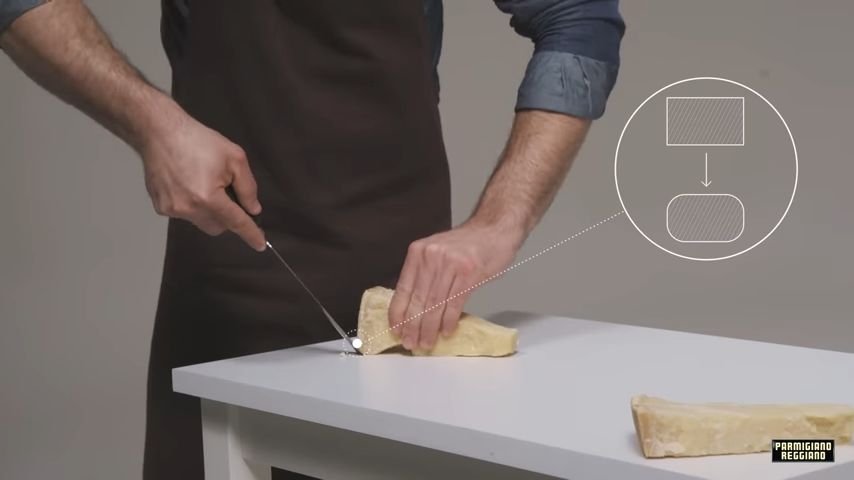
Take care to round off any sharp edges to prevent damage to the delicate wrap used for packaging.
By adhering to these practices, you can uphold the integrity and freshness of Parmigiano Reggiano cheese, ensuring customers receive the finest product possible.
How long can you keep Parmigiano Reggiano
Entire wheel
You can store the entire wheel of Parmigiano Reggiano for several months under conditions resembling those of an ageing storeroom. Of course, you will want to regularly clean the rind to maintain its freshness.
Furthermore, you must maintain a temperature range of 16-18°C (61-64°F), with low lighting and a high level of relative humidity.
Portioned pieces
For freshly portioned products, they can be stored in the refrigerator for several days in an airtight container, a transparent food bag, or wrapped in transparent food wrap.
If you notice a thin layer of fat or mould, don’t be alarmed. You can restore the cheese to its prime condition by removing the affected parts and cleaning the surface.
If you carry cheeses of different ages, create a sign or chalkboard explaining their distinct characteristics.
For further information and valuable tips, visit the consortium’s website, where you can find a wealth of useful resources.
Conclusion
In the world of cheese, Parmigiano Reggiano stands as an epitome of craftsmanship and flavour. As we’ve journeyed through this comprehensive guide, you’ve discovered the intricate art of cutting this iconic Italian cheese, transforming a seemingly daunting task into a skilled craft.
Understanding the origins, properties and dimensions of the Parmigiano Reggiano wheel is the foundation upon which every cheesemonger builds their expertise. From meticulous preparation, identification, and choosing the right knives to the delicate process of cutting and storing, each step plays a crucial role in preserving the integrity of this culinary treasure.
By embracing the knowledge shared here, you’ve not only learned the techniques but also the respect and admiration this cheese deserves. The careful attention given to every slice ensures that the legacy of Parmigiano Reggiano continues, delighting the palates of cheese connoisseurs around the world.
As you embark on your cheese-cutting journey, remember that Parmigiano Reggiano is more than a cheese—it’s a testament to tradition, quality, and the artistry of cheesemaking.
So, with your newfound expertise, share the joy of this delectable cheese, enhancing the experiences of those fortunate enough to savour your expertly cut Parmigiano Reggiano. Happy slicing!
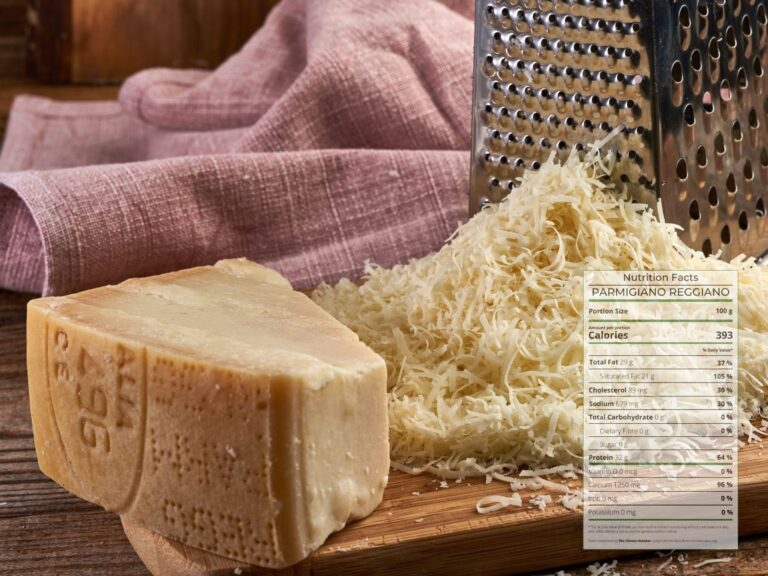
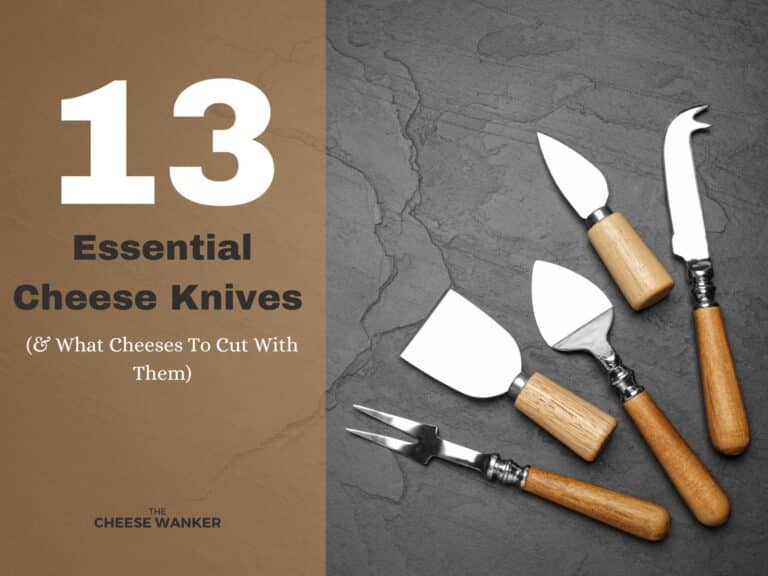

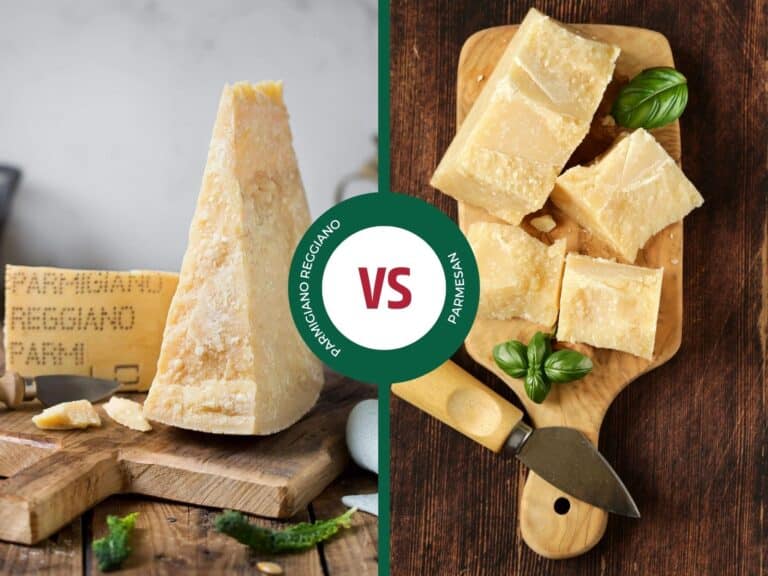
Hello, I am a young cheese seller in Turkey. The city I live in is a warm coastal city in the Mediterranean region. That’s why we keep our products in our warehouse at 4 degrees. Our parmigiano reggiano wheels are also available here. But the writings on them began to disappear and turn white as the day passed. Our city is 35-40 degrees in summer and 15-20 degrees in winter. What should we do about this? Please I would be very happy if you help me